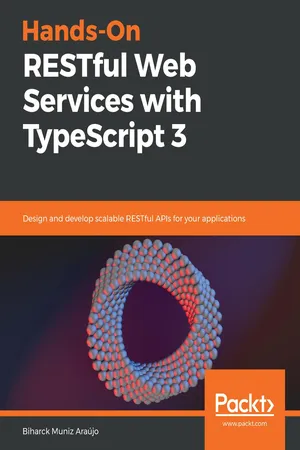
Hands-On RESTful Web Services with TypeScript 3
Design and develop scalable RESTful APIs for your applications
- 470 pages
- English
- ePUB (mobile friendly)
- Available on iOS & Android
Hands-On RESTful Web Services with TypeScript 3
Design and develop scalable RESTful APIs for your applications
About This Book
A step-by-step guide that will help you design, develop, scale, and deploy RESTful APIs with TypeScript 3 and Node.js
Key Features
- Gain in-depth knowledge of OpenAPI and Swagger to build scalable web services
- Explore a variety of test frameworks and test runners such as Stryker, Mocha, and Chai
- Create a pipeline by Dockerizing your environment using Travis CI, Google Cloud Platform, and GitHub
Book Description
In the world of web development, leveraging data is the key to developing comprehensive applications, and RESTful APIs help you to achieve this systematically. This book will guide you in designing and developing web services with the power of TypeScript 3 and Node.js. You'll design REST APIs using best practices for request handling, validation, authentication, and authorization. You'll also understand how to enhance the capabilities of your APIs with ODMs, databases, models and views, as well as asynchronous callbacks. This book will guide you in securing your environment by testing your services and initiating test automation with different testing approaches. Furthermore, you'll get to grips with developing secure, testable, and more efficient code, and be able to scale and deploy TypeScript 3 and Node.js-powered RESTful APIs on cloud platforms such as the Google Cloud Platform. Finally, the book will help you explore microservices and give you an overview of what GraphQL can allow you to do.
By the end of this book, you will be able to use RESTful web services to create your APIs for mobile and web apps and other platforms.
What you will learn
- Explore various methods to plan your services in a scalable way
- Understand how to handle different request types and the response status code
- Get to grips with securing web services
- Delve into error handling and logging your web services for improved debugging
- Uncover the microservices architecture and GraphQL
- Create automated CI/CD pipelines for release and deployment strategies
Who this book is for
If you're a developer who has a basic understanding of REST concepts and want to learn how to design and develop RESTful APIs, this book is for you. Prior knowledge of TypeScript will help you make the most out of this book.
Frequently asked questions
Information
Section 1: Unraveling API Design
- Chapter 1, Introduction to RESTful Web Service Development
- Chapter 2, Principles of Designing RESTful APIs
- Chapter 3, Designing RESTful APIs with OpenAPI and Swagger
Introduction to RESTful API Development
- The REST definition
- RESTful styles
- The general concepts regarding REST
- HTTP methods and verbs
Technical requirements
What is REST?
REST architectural styles
- Uniform interface
- Stateless
- Cacheable
- Client-server architectu...
Table of contents
- Title Page
- Copyright and Credits
- Dedication
- About Packt
- Foreword
- Contributors
- Preface
- Section 1: Unraveling API Design
- Introduction to RESTful API Development
- Principles of Designing RESTful APIs
- Designing RESTful APIs with OpenAPI and Swagger
- Section 2: Developing RESTful Web Services
- Setting Up Your Development Environment
- Building Your First API
- Handling Requests and Responses
- Formatting the API - Output
- Section 3: Enhancing RESTful Web Services
- Working with Databases and ODMs
- Securing Your API
- Error Handling and Logging
- Creating a CI/CD Pipeline for Your API
- Section 4: Extending the Capabilities of RESTful Web Services
- Developing RESTful APIs with Microservices
- Flexible APIs with GraphQL
- Assessments
- Other Books You May Enjoy